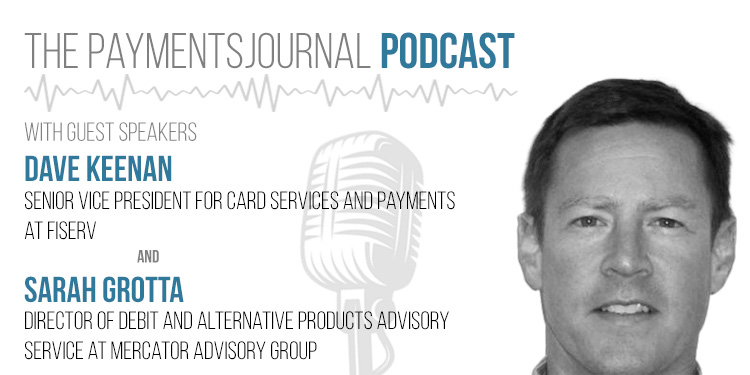Podcast: Play in new window | Download
The technology and payment rails to enable real-time payments in the U.S. already exist, though real-time and faster payments still have not entirely permeated the U.S. financial system.
That’s because many of the more than 10,000 banks and credit unions in the U.S. today have been slow to adopt real-time payments. The reasons for this are myriad, including the complexity of integrating new payments types, the complexity of dealing with different payment rails, and the fact there is a lack of a federal mandate to do so.
However, financial institutions need to embrace faster payments and real-time payments now or risk being left behind. To find out why this is such a pressing issue for banks and credit unions, PaymentsJournal sat with Dave Keenan, Senior Vice President for Card Services and Payments at Fiserv, and Sarah Grotta, Director of Mercator Advisory Group’s Debit and Alternative Products Advisory Service.
The Time is Now
Keenan began by observing that consumers and businesses are increasingly expecting real-time payments, and failing to deliver that can lead to severe consequences down the road.
“There is going to be a sea change in payments that is going to drive different consumer and business behavior, and financial institutions are going to need to adapt if they are going to retain those relationships,” he added.
Luckily, for banks and credit unions that have not begun down this path, it’s still not too late. But they cannot delay any longer.
“You’re not out of the game if you are still at [the] starting blocks; don’t worry, it’s still a marathon not a sprint,” Keenan said. “But it’s time to move.”
He advised financial institutions to talk with their trusted vendor partners about how they can help and find out what options are available immediately, as well as “find out what your customers, your members, want and what solutions they are using. That is a good indicator of what they will value.”
Grotta noted that many banks and credit unions don’t need to immediately start with the most cutting-edge real-time payments technology, but rather, can start by taking small steps.
“Some financial institutions are also waiting for the right business case to materialize or for the market to mature,” she continued. “But your customers want this now. You can start with a few use cases to get your feet wet.”
Peer-to-peer (P2P) payments are a clear example where real-time settlement can be implemented, Keenan said. Enabling workers in the gig economy to get paid faster is another. He cited research showing that more than 50% of gig economy workers are willing to pay a fee to get paid immediately as proof of the demand in this area.
There are also numerous business-to-business use cases, such as vendors getting paid immediately after making a shipment to a client.
“Small businesses, which rely greatly on cash flow, want this,” he added. “Pretty much everybody prefers when they are owed money to get it faster, and we are just now starting to see a number of use cases blossom.”
Grotta added that there are internal efficiencies that banks and credit unions can also realize by implementing real-time payments. Fraud detection, for example, can be more robust because it can spot potential attacks or fraudulent patterns in real time as opposed to long after the fraud attacks have occurred.
Financial institutions can also make better use of customer data to gain greater insight into spending patterns or cash flow trends and be able to offer more proactive assistance to clients.
“There’s a lot of opportunities,” she added. “I don’t think we’ve really scratched the surface yet.”
Taking Advantage of Technology
Technology already exists today to enable real-time payments. the ATM. When a consumer takes out cash from an ATM that is not operated by their financial institution, that ATM operator has to “talk” to the withdrawer’s institution to ensure there is enough money in the account to meet the cash withdrawal request. If there is, the cash is dispensed and the account is debited. This is all done in real time.
“We’re talking about technology that is 50 years old,” Keenan said. “The rails to support this are very mature.”
Keenan further noted that over the next 10 years, the amount of money moved by real-time payments networks will exceed that of the card ecosystem today.
“And that’s very exciting,” he added.
Grotta said that banks and credit union clients will not care what technology is used or how their institution provides real-time payments, just that they do so and that the user experience is topnotch.
“If you look at the P2P payments space, it has taken off because the user experience is so good, and when someone gets money through a P2P app, they know it is available to them immediately,” she said. “They don’t care what is happening in the back office.”
And more and more consumers every day want this experience.
“Consumers and businesses want to do business with those solutions that help them get their money faster,” said Keenan. “That’s just obvious.”










